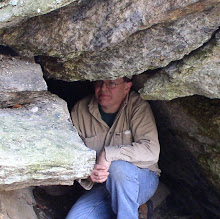So on I continued with my deliberate and systematic search of ledges within the Valley mountains. Picking out a section that on the topographical map looked promising, I parked and headed out into the woods. Once again I hoped that I might come across the long lost "Warner's Ledge" photographed some one-hundred and forty years earlier.
With time, things (of course) have changed and access to the mountains is often blocked by nice spiffy newer homes. But finding a rare piece of property not built upon, I made my way into a series of conglomerate ledges that yielded but a couple of very small cave formations. I zigzagged on up in elevation until I stumbled on in to an old 'friend' in the form of Graves' Ledge or the Rock Shelter.
I always can find something new - or check some of the old photography done here - so I decided to proceed down the entire length passing all the favorites at Castle End, Etta's Nook, Rock Roof, etc., etc. and finally pulled up at Willard's Point. Consulting with my stash of antique photography, I realized I had not done a good job previously in matching my modern day photographs to the older one. Careful analysis, and correct positioning of the camera tripod, brought me a much better representation although the Point itself is now somewhat obscured by the trees.
Adjacent to Willard's are the Twin Slabs which really are a section of the conglomerate ledges that have tumbled forth and landed upon their sides. And just beyond this, the always impressive Rock Rift. I mulled over the possibility of a photo shoot but with heavy tree cover found it not worth the effort at this point in time.
It was at this point I decided to do Graves' the whole length. Something I had not done since I originally stumbled on into it some five years ago. So the next Victorian Age feature in the photographic series was Fortress Rock. This section of ledge is a mighty monolith of stone separating into two levels just beyond the Rock Rift and running for a couple hundred yards only to come together again near the site that the old photograph depicts.

Annie's Retreat
Upon leaving the 'Fortress' the massive ledges continue on a bit farther with Annie's Retreat being the last in the photographic series on these set of rocks. Annie's is a comfortable cave formation in the base of the rocks and would be the ideal picnic spot in The Victorian Age or even today. From here I followed on out what rock ledges were left. Then down from the mountain to the highway and back to the car.






